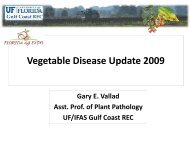The potential of oil seed crops as beneficial ... - Florida Ag Expo
The potential of oil seed crops as beneficial ... - Florida Ag Expo
The potential of oil seed crops as beneficial ... - Florida Ag Expo
You also want an ePaper? Increase the reach of your titles
YUMPU automatically turns print PDFs into web optimized ePapers that Google loves.
<strong>The</strong> <strong>potential</strong> <strong>of</strong> <strong>oil</strong> <strong>seed</strong> <strong>crops</strong> <strong>as</strong> <strong>beneficial</strong> rotation<br />
<strong>crops</strong> for <strong>Florida</strong> fruit and vegetable growers<br />
Dan O Chellemi, USDA, ARS, Horticultural Research Laboratory
<strong>Florida</strong> vegetable growers are <strong>of</strong>ten reluctance to<br />
plant cover <strong>crops</strong> despite knowledge <strong>of</strong> their<br />
benefits to s<strong>oil</strong> quality and pest management
In a survey <strong>of</strong> California tomato and safflower<br />
farmers, 28% acknowledged planting cover <strong>crops</strong><br />
despite a broad understanding <strong>of</strong> their benefits to<br />
s<strong>oil</strong> quality (Ridgley and Van Horn, 1995).
In a survey <strong>of</strong> 3,500 Midwestern US farmers, 18%<br />
reported using cover <strong>crops</strong> even though most<br />
believed that doing so would incre<strong>as</strong>e s<strong>oil</strong> organic<br />
matter and reduce erosion (Singer et al., 2007).
<strong>Ag</strong>ronomic and pest management benefits do not outweigh<br />
the cost and time required to plant and manage them
Key consideration<br />
Horticultural<br />
• Improving s<strong>oil</strong> quality<br />
• Suppressing populations <strong>of</strong><br />
s<strong>oil</strong>borne pests
Key considerations<br />
• Added revenue streams<br />
Economic<br />
Jobs for rural<br />
communities<br />
Social
Key considerations<br />
• Yield <strong>potential</strong> and limitations<br />
Economic<br />
<strong>Ag</strong>ronomic
Key considerations<br />
• Cropping cycle<br />
<strong>Ag</strong>ronomic
Key considerations<br />
Economic<br />
• Adaptability<br />
<strong>Ag</strong>ronomic<br />
Integration into farm<br />
production system <strong>as</strong> a<br />
<strong>beneficial</strong> rotation crop negates<br />
the ‘Food vs Fuel’ debate<br />
Social
Key considerations<br />
Economic<br />
• Susceptibility to pests<br />
<strong>Ag</strong>ronomic
Key considerations<br />
Economic<br />
<strong>Ag</strong>ronomic<br />
• Input requirements<br />
Environmental
Key considerations<br />
Economic<br />
• Resource consumption<br />
Environmental<br />
Social
Sunflower <strong>as</strong> an <strong>oil</strong>-<strong>seed</strong> rotation crop<br />
for <strong>Florida</strong> tomato producers
Crop yields<br />
Oct 2007 planting date<br />
Variety<br />
Harvest<br />
Date<br />
Seed<br />
lbs/acre<br />
Seed <strong>oil</strong><br />
content<br />
% <strong>oil</strong><br />
extracted<br />
Oil<br />
gal/acre<br />
Meal<br />
lbs/acre<br />
s672 Feb 11 1,793 46.9% 39.7% 92.8 990.1
Test Name Test Method Limit 10 Oct. 2007<br />
planting date<br />
3 Mar. 2008<br />
planting date<br />
Free glycerin ASTM D6584 Max 0.02 0.003% 0.000%<br />
Monoglycerides ASTM D6584 Not available 0.023% 0.076%<br />
Total glycerin<br />
ASTM D6584<br />
Max 0.24 0.035% 0.087%<br />
Total acids ASTM D664 Max 0.50 0.42 mg KOH g -1 0.11 mg KOH g -1<br />
Oxidation<br />
EN 14112 Min 3.00 hrs 0.52 hrs 1.26 hrs<br />
stability index
Issues<br />
Lodging from wind-driven rain
Issues<br />
Residual herbicide in s<strong>oil</strong>
Projected returns for sunflower<br />
(yield=1,800 lbs/acre, 93 gal <strong>oil</strong>/acre)<br />
200 acre farm 2,000 acre farm<br />
Breakeven – <strong>seed</strong> $ 0.30 lbs -1 $ 0.29 lbs -1<br />
Breakeven - <strong>oil</strong> $ 5.87 gal -1 $ 5.07 gal -1
Feed analysis <strong>of</strong> sunflower cake (expressed <strong>as</strong> % wet weight).<br />
Variety Moisture Digestible Total Ash Nitrate<br />
protein digestible (NO 3 )<br />
Dwarf<br />
hybrid<br />
(s672)<br />
Herbicide<br />
resistant<br />
hybrid<br />
(660Cl)<br />
Traditional<br />
linoleic<br />
hybrid<br />
(545A)<br />
calcium P<br />
nutrients<br />
5.51 23.20 80.98 6.64 0.13 0.52 1.20<br />
7.61 20.32 72.90 6.50 0.09 0.34 1.13<br />
7.22 23.59 75.52 6.98 0.09 0.32 1.31
Crop budget for sunflower (2/24/2009)<br />
120 acres 2,000 acres<br />
Total variable costs $630 acre -1 $572 acre -1<br />
Land prep 13.6% 12.7%<br />
Fertilizer 55.2% 48.6%<br />
Land prep + fertilizer 68.8% 61.3%
Aeschynomene – sunflower – camelina<br />
rotation<br />
July 2 July 22<br />
Disk<br />
fallow
Aeschynomene cover crop<br />
lbs N per acre<br />
Crop age Contribution<br />
88 days 227 lbs<br />
67 days 182 lbs
Aeschynomene cover crop<br />
lbs carbon per acre<br />
Crop age Contribution<br />
88 days 3,294 lbs<br />
67 days 2,514 lbs
Yield <strong>of</strong> camelina following a legume, green<br />
manure cover crop and a sunflower crop<br />
Yield (lbs acre -1 )<br />
700<br />
650<br />
600<br />
550<br />
500<br />
450<br />
400<br />
N applied to<br />
sunflower crop<br />
70 lbs N<br />
140 lbs N<br />
350<br />
300<br />
No cover<br />
crop<br />
Aeschynomene<br />
67 days<br />
Aeschynomene<br />
88 days
Gracie !<br />
Graci<strong>as</strong> !<br />
Mahalo!<br />
Merci ! Thank you !




